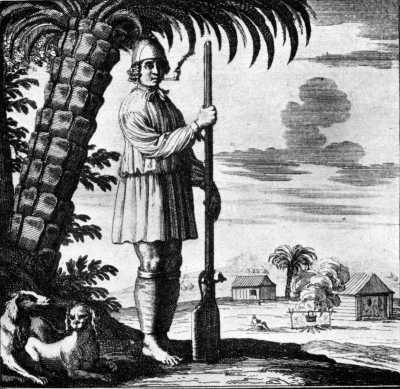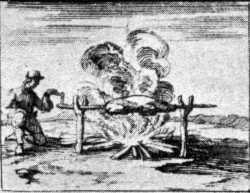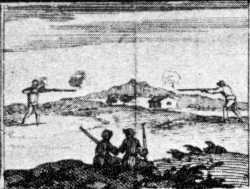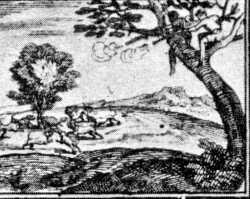 |
|
A Buccaneer with his musket and dogs |
The Pirates and Buccaneers
In the History of Panamá
 |
|
A Buccaneer with his musket and dogs |
| Pirate's Name | Year(s) in Panamá | Country |
| John Oxenham | 1572 & 1577 | 
|
| Francis Drake | 1572, 1573 & 1597 | 
|
| Andrew Barker | 1576 | 
|
| William Parker | 1601 |

|
| Edvart Mansveldt | 1666 | 
|
| François l'Ollonois | 1667 | 
|
| Henry Morgan | 1669 & 1671 | 
|
| Joseph Brodely | 1671 | 
|
| La Sound | 1675 | 
|
| Bournano | 1678 | 
|
| Captain Coxon | 1679 | 
|
| Juan Guartem Eduardo Blomar Bartolomé Charpes |
1679 | |
| Bartholomew Sharp | 1679 | 
|
| Lionel Wafer | 1679 | 
|
| William Dampier | 1680 | 
|
| Edward Vernon | 1739 | 
|

England |

French |

Dutch |
Spanish |
 |
 |
|
Smoking Bucan |
Hunters shooting wild cattle |
 |
|
Using dogs to hunt cattle |
| The Buccaneers and Filibusters
They were men who had shipwrecked or escaped from Spanish prisons, or marooned sailors or runaways. They consisted of groups of English, Dutch and French that existed solely on hunting. They inhabited primarily the island of Española, on the north-western part of the island. This part of the island was poorly inhabited by the Spaniards allowing the foreigners to range freely. On this side of the island, there were large number of domesticated animals (cattle, pigs, horses and dogs) that had turned wild, and were available for the taking. There were very few women or children in these groups, and the men lived wildly. Their only processions were the weapons they carried, knives, cutlass and rifles. They hunted the wild cattle and pigs with the help of packs of dogs, they had captured and trained. The animals they killed, was smoked to preserve the meat (no refrigeration), according to a method they learned from the natives. Strips of meat were placed on a rack, made of branches and slowly smoked over hot embers of charcoal. The natives referred to the smoked meat, as "Bucan", the Europeans hunters, called the process, "Buccaneering" and called themselves "Buccaneers". The Buccaneers were distinctive cloths, which consisted of a coarse shirt, which hung loosely over the pants. His pants were loose fitting and normally only reached their knees. They carried their rifle, power pouches, and collection of butcher knifes and a hat to protect them from the sun. Originally, they proceeded the meat for their own consumption, and limited trading with the Spaniards. They started trading with the Pirates and other sailors that were sailing the Spanish Main. Towns sprouted up in the area, in particularly, the area that is now Haiti. Towns like Port Paix, Port Margot, Cape Francis, attracted more Buccaneers, and grew. Up too them, the Spaniards did not bother with them; but, as their towns grew larger, the Spanish declared war on them. The Spaniards were successful in routing the Buccaneers, and those that escaped, moved to an island on the north coast a short distance from Port Paix, that was named, Tortuga, because it had the shape of a turtle. Tortuga was a very defensible island, and the Buccaneers started to use it has their fortress, from which to harass the Spaniards in Española and then the Caribbean. Originally, Tortuga's main inhabitants were English Buccaneers. Later a Frenchman, Levasseur, settled there, and brought with him a large number of French. The French eventually outnumbered the English, and it became a French colony, with administrators being sent by the French government. The Spanish, in an attempt to get rid of the Buccaneers, permanently, started killing most of the large animals in Española, to deny the Buccaneers their lively hood. They were so successful in this task, that the Buccaneers had to turn to piracy. Instead of hunting game, they started to hunt Spanish Galleons. The Englishmen called themselves "Freebooters", the Frenchmen called them "flibustier", and the English then called the French, "Filibuster". Originally, the term, Buccaneer and Filibuster were two different things, each meaning something different. Eventually, both terms had the same meaning, they were either English or French pirates. A very important attribute of the Buccaneers, was that they were excellent marksmen. Since they depended on the ability to shoot a wild animal from a distance, and not waste valuable shot and powder. This skill proved to be very deadly for the Spaniards in their battles with the pirates. Over and over again, the skilled marksmen proved their worth when they attacked Spanish shipping and settlements. |
Bruce C. Ruiz
September 19, 2002